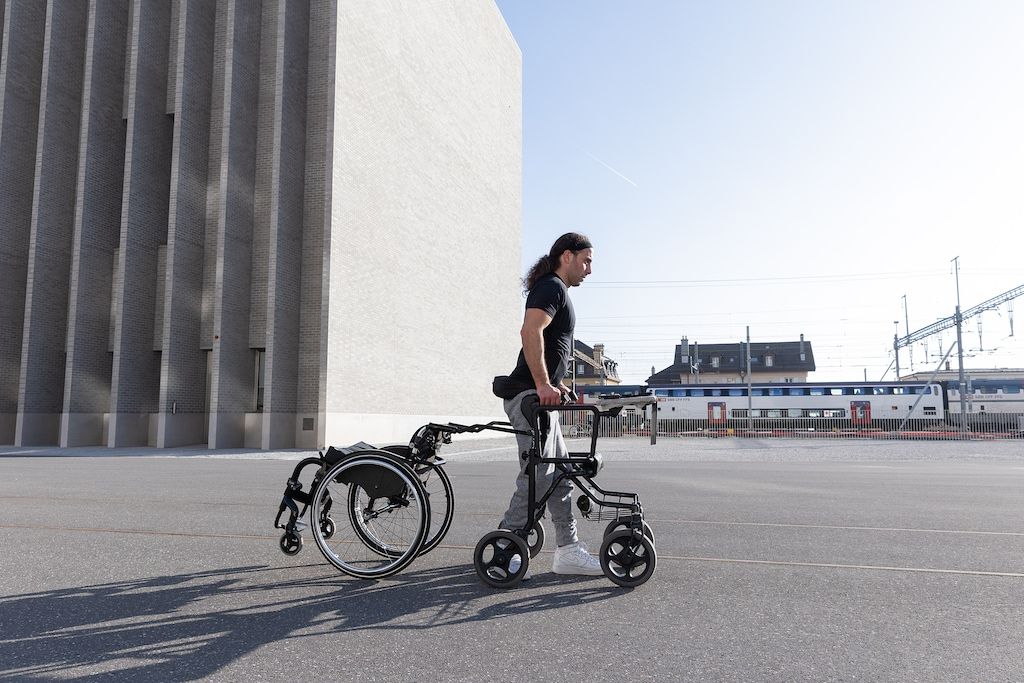Michel Roccati, a patient with complete spinal cord lesion, had the Epidural Electrical Stimulation (EES) of the spinal cord implanted in 2021. Here Roccati tows his wheelchair with the support of a walker that connects to the ESS. photos: Rolex
We live in a time when the frontiers of science and technology converge, revealing the incredible potential of innovation in medical science.
From battling devastating illnesses to finding solutions for life-altering injuries, the synergy of human ingenuity and cutting-edge technology promise breakthroughs that can transform the future of medicine and beyond.
Rolex Awards for Enterprise Laureate Gregoire Courtine lives with the goal of finding a lasting cure for paralysis caused by spinal cord injury (SCI).
The co-director of .Neurorestore has dedicated his career to this cause, working towards a day when it will be possible for someone to be admitted to hospital with paralysis after an SCI, receive treatment, and walk out a few weeks later.
“I live with this obsession, this restlessness. Until a cure is achieved, I will never stop,” says Courtine.
Pioneering new medical technology
In 2019, Courtine received a Rolex Award for Enterprise for his idea to create a spinal implant that could connect to the wearer’s brain via a “digital bridge”, which he has been developing with his research partner, neurosurgeon Jocelyn Bloch.
According to Bloch, the spinal cord is like a highway, and following a spinal cord injury, this highway is interrupted.
“The brain is still active, it wants to give signals, but these signals are interrupted at the level of the injury. We have created a digital bridge to reconnect the brain and the spinal cord with electrical recordings and stimulation,” said Bloch.
The digital bridge is made up of two implants, one on the part of the brain associated with movement and another on the spine, below the injury.
The first records electrical signals generated by the brain and sends it to the second, bridging the gap and allowing patients to stimulate movements through thought alone.
By 2022, Courtine and Bloch were ready to implant their device with the help of a previous patient of theirs, Gert-Jan Oskam, who immediately volunteered to be their test pilot.
Following a serious cycling accident in 2011, Oskam was told he would never walk again.
Oksam, who at the time was working as a logistics coordinator in China, remained defiantly hopeful despite the news.
“I never accepted that answer,” said Oskam, who was implanted with digital bridge between his brain and his spinal cord.
The operation was a success – within minutes the digital bridge enabled Oskam to control an avatar of his body on a computer using mental cues, and within a few days, he was able to move his legs.
Paralysis treatment and beyond
The Epidural Electrical Stimulation (EES), an implant that delivers electrical pulses to patients’ spinal cords below the injury to stimulate movement, was Courtine’s first breakthrough.
Courtine and Bloch observed that not only did the implant grant patients instant mobility, but that continued use actually compounded the improvement, as damaged spinal neurons began to repair themselves.
While these results were remarkable, for Courtine, the process was not fluid, or “natural” enough, as the EES requires patients to press a button to signal the implant on their spine, manually stimulating their legs for each step they wanted to take.
This drove him to develop the digital bridge, which could literally “convert thoughts into action.”
The next step will be to combine the repair of nerve fibres seen in users of the EES with the digital bridge, to help patients fully regain the movement they lost.
Spurred on by his Rolex Award, Courtine is hopeful that his team will be able to refine the technology and make it affordable and convenient enough to be available to people around the world.
“The whole team felt empowered by receiving the Rolex Award for Enterprise. The fact that a jury of experts believed in our work; it energised us. We felt emboldened to push forward, further into the unknown,” said Courtine.
Additionally, the EES has recently been found to be highly effective in the treatment of patients who have suffered strokes and those with Parkinson’s.
With the support of Rolex, Courtine and Bloch inch closer to their dream of a world in which paralysis caused by SCI is a treatable condition.
Perpetual Planet Initiative
For nearly a century, Rolex has supported pioneering explorers pushing back the boundaries of human endeavour.
The company has moved from championing exploration for the sake of discovery to protecting the planet, committing for the long term to support individuals and organisations using science to understand and devise solutions to today’s environmental challenges.
This engagement was reinforced with the launch of the Perpetual Planet Initiative in 2019, which initially focused on the Rolex Awards for Enterprise, as well as longstanding partnerships with Mission Blue and National Geographic Society.
The initiative now has more than 20 other partnerships in an expanding portfolio. They include, for example, Cristina Mittermeier and Paul Nicklen, Rewilding Argentina and Rewilding Chile, offspring organisations of Tompkins Conservation, the Under The Pole expeditions, the Monaco Blue Initiative, and Coral Gardeners.
Rolex also supports organisations and initiatives fostering the next generations of explorers, scientists and conservationists through scholarships and grants, such as Our World-Underwater Scholarship Society and The Rolex Explorers Club Grants.










